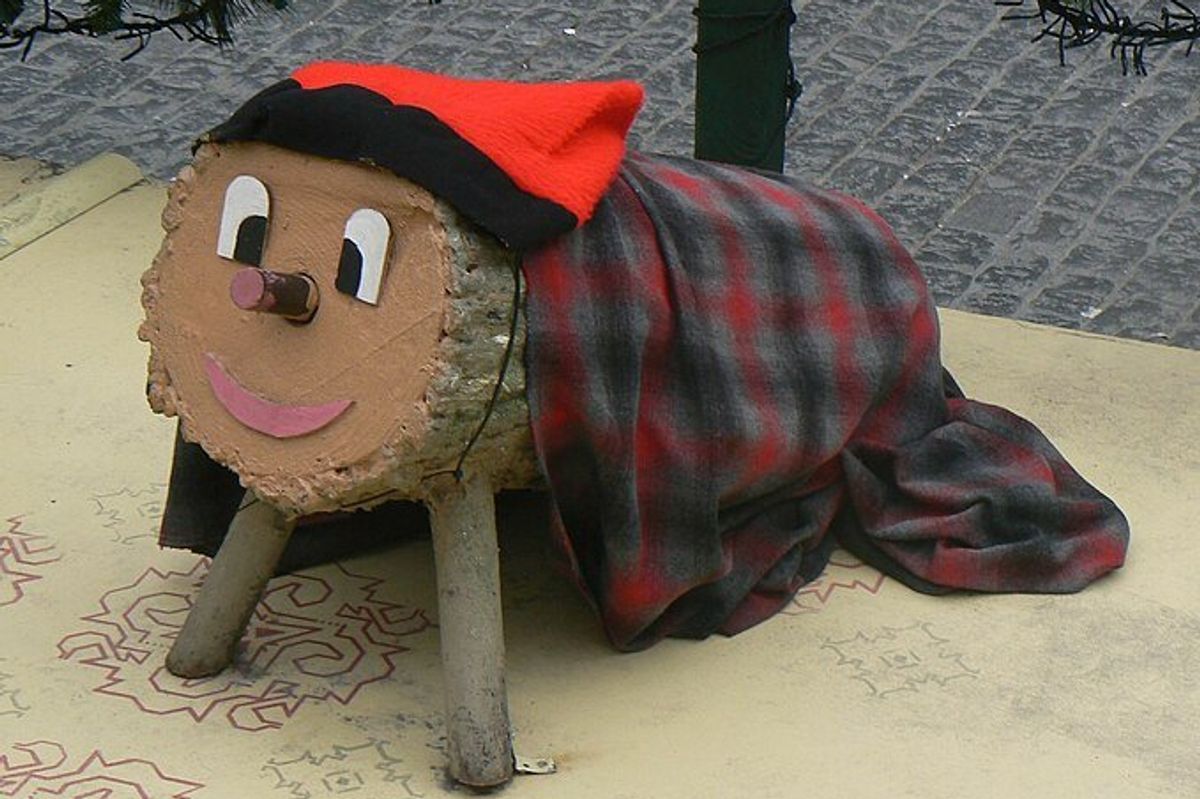9 of the most intriguing Christmas-time traditions from around the world
From the log that poops out Christmas presents in Catalonia to a towering cat that eats lazy children in Iceland, here are some fascinating holiday traditions that have emerged around the globe.

The Tió de Nadal eats food scraps and poos candy and presents.
Christmas is celebrated around the world, but it looks a bit different everywhere you go. While there are some fairly universal traditions, such as decorating a tree and giving gifts, there are some traditions specific to different cultures that are both unique and intriguing.
Check these out:
1. ITALY—La Befana: The Good Witch

2. ICELAND—The Yule Lads
Iceland’s 13 Yule Lads are merry and mischievous troll-like figures, each with a different name and personality. They visit children one at a time during the 13 days leading up to Christmas, leaving gifts and playing tricks, including leaving rotten potatoes in the shoes of kids who don’t behave. According to the Smithsonian, the Yule Lads used to be a lot creepier, but in 1746, the country outlawed scaring children with monstrous tales about the 13 lads. (Would love to know what prompted that law!)
3. ALSO ICELAND—The Yule Cat

Yule Cat on display in downtown Reykjavik, December 2022
ProcrastinatingHistorian/Wikimedia Commons
As if the Yule Lads weren’t enough, a towering, fearsome cat roams the Icelandic countryside around Christmastime, peeking into homes to spy on children’s presents. In Icelandic tradition, if kids get all of their chores done, they are gifted some new clothes. If the Yule Cat (aka Jólakötturinn) sees that a child wasn’t given clothes (in other words, a child was lazy), the cat proceeds to eats the child’s dinner and then moves on to eating the child. Yes, you read that right. It eats the child. Icelandic folklore doesn’t mess around.
4. PHILIPPINES—The Giant Lantern Festival

Giant Lantern Festival 2012
Ramon FVelasquez/Wikimedia Commons
In the Philippines, the Giant Lantern Festival is held in San Fernando City (dubbed the Christmas capital of the Philippines) every year the week before Christmas Eve. According to Travel & Leisure, the lantern tradition is rooted in the history of Filipino Catholics building small, colorful lanterns to light up the procession to Christmas Eve mass. The giant parol lanterns for the festival, however, are huge—up to 20 feet tall—and it can take up to 10,000 light bulbs to illuminate them.
5. SPAIN (CATALONIA)—The Tió de Nadal (pooping log)

The Tió de Nadal is a Catalan Christmas tradition.
Public Domain/Wikimedia Commons
Some cultures have a yule log. Catalonia, Spain, has the Tió de Nadal—a log with a hat, a blanket, a smiley face and a penchant for pooping out presents. Children feed the smiling log scraps of food at night and it poop out presents on Christmas Day. There's even a song kids sing to the log, imploring it to not poop out salted herring (too salty), but nougats in instead, all while hitting the log with a stick. According to Catalan tradition, the eating of the scraps and the beating with the stick leads to Tió de Nadal pooping out presents and nougat on Christmas. And apparently, no one questions it.
6. BAVARIA—The Krampus

Krampus costume
Anita Martinz/Wikimedia Commons
In Bavaria (which includes Austria, Germany, Switzerland and some of the surrounding area), the Krampus is a centuries-old tradition that has been revived in modern times. The Krampus is a horned, hairy, hellish creature who follows St. Nick on his rounds to punish naughty children by scaring them (or tossing them in a sack and beating them). Many cities hold Krampus festivals each year, where people parade around in Krampus costumes like the one above.
7. VENEZUELA—Roller Skating to Christmas Mass

Venezuelans roller skate on Christmas
Photo by Daniel Lincoln on Unsplash
Most of us don't association Christmas with roller skating, but that's not the case for Venezuelans. Christmas is an all-night roller skating party, which includes singing Christmas songs and culminates with everyone rolling their way to Christmas Mass at dawn. Most interestingly, according to a Venezuelan woman's explanation in America Magazine, it's not even like Venezuelans are a big roller skating culture the rest of the year—it's just a Christmas thing.
8. JAPAN—A Finger Lickin' Good Tradition

KFCs are packed for Christmas in Japan
Photo by Stabel Webel on Unsplash
Japan doesn't have a long history with Christmas and thus no long-standing traditions associated with it. What they do have is 50 years of eating KFC for Christmas, thanks to a "Kentucky for Christmas" marketing campaign launched by the first KFC restaurant owner in Nagoya, Japan, in 1970. Somehow, it stuck and is now a beloved tradition for millions of Japanese families.
9. UKRAINE—Spider Webs on Christmas Trees

Ukrainians celebrate spiders at Christmas.
According to Ukrainian legend, an impoverished widow and her children grew a tree from a pinecone outside of their house, but they were too poor to decorate it for Christmas. The household spiders heard the children's sobs and spun their webs into decorations overnight. When the children awoke on Christmas morning, they cried out “Mother, mother wake up and see the tree. It is beautiful!” As the day went on and the sun's rays hit the delicate webs, they transformed into silver and gold and the widow never wanted for anything again. Today, Ukrainians decorate trees with spider webs for good luck and fortune in the new year.
Whatever your family or cultural holiday traditions are, let's celebrate the differences that make our world so interesting.
- These millennials demonstrate there's no wrong way to make a little holiday magic. ›
- A powerful case for why we should only celebrate Christmas every other year. ›
- Drew Barrymore explains why she opts for experiences instead of Christmas gifts for her kids ›
- Adults act out the Christmas story according to kids - Upworthy ›



 Millennial mom struggles to organize her son's room.Image via Canva/fotostorm
Millennial mom struggles to organize her son's room.Image via Canva/fotostorm Boomer grandparents have a video call with grandkids.Image via Canva/Tima Miroshnichenko
Boomer grandparents have a video call with grandkids.Image via Canva/Tima Miroshnichenko

 Worried mother and children during the Great Depression era. Photo by Dorthea Lange via Library of Congress
Worried mother and children during the Great Depression era. Photo by Dorthea Lange via Library of Congress  A mother reflects with her children during the Great Depression. Photo by Dorthea Lange via Library of Congress
A mother reflects with her children during the Great Depression. Photo by Dorthea Lange via Library of Congress  Families on the move suffered enormous hardships during The Great Depression.Photo by Dorthea Lange via Library of Congress
Families on the move suffered enormous hardships during The Great Depression.Photo by Dorthea Lange via Library of Congress
 A couple cooking in the kitchen with a cat sitting on the table beside chopped ingredients.
A couple cooking in the kitchen with a cat sitting on the table beside chopped ingredients.